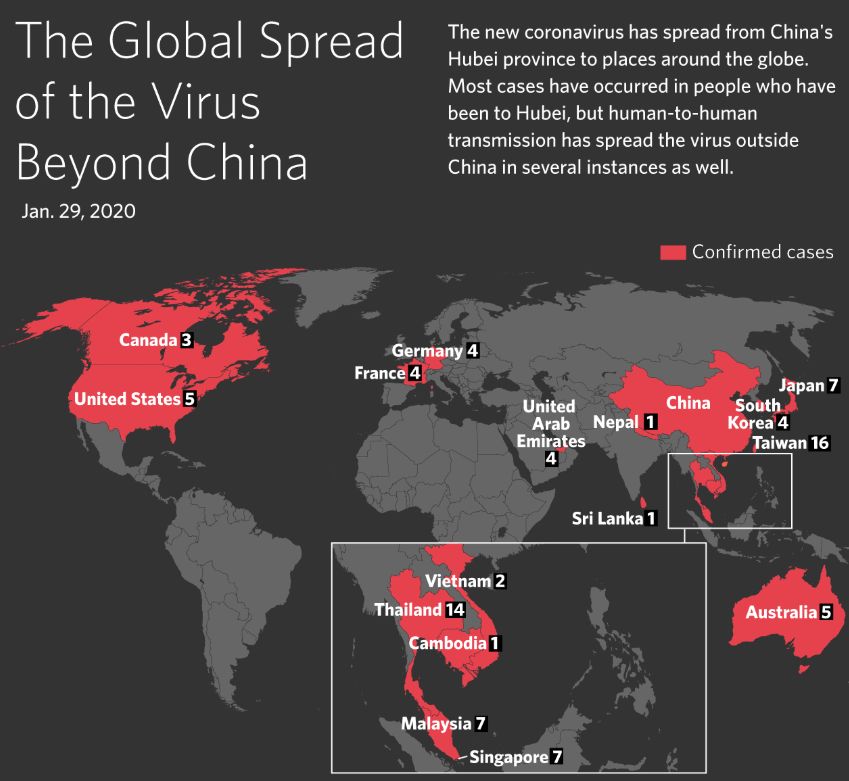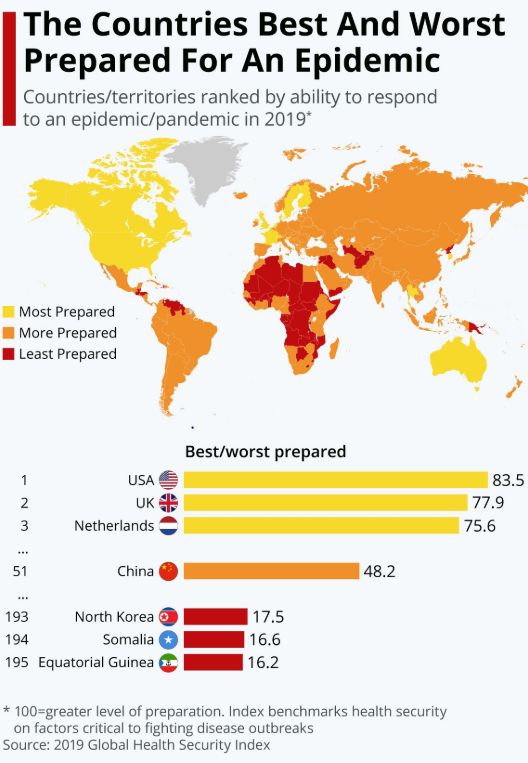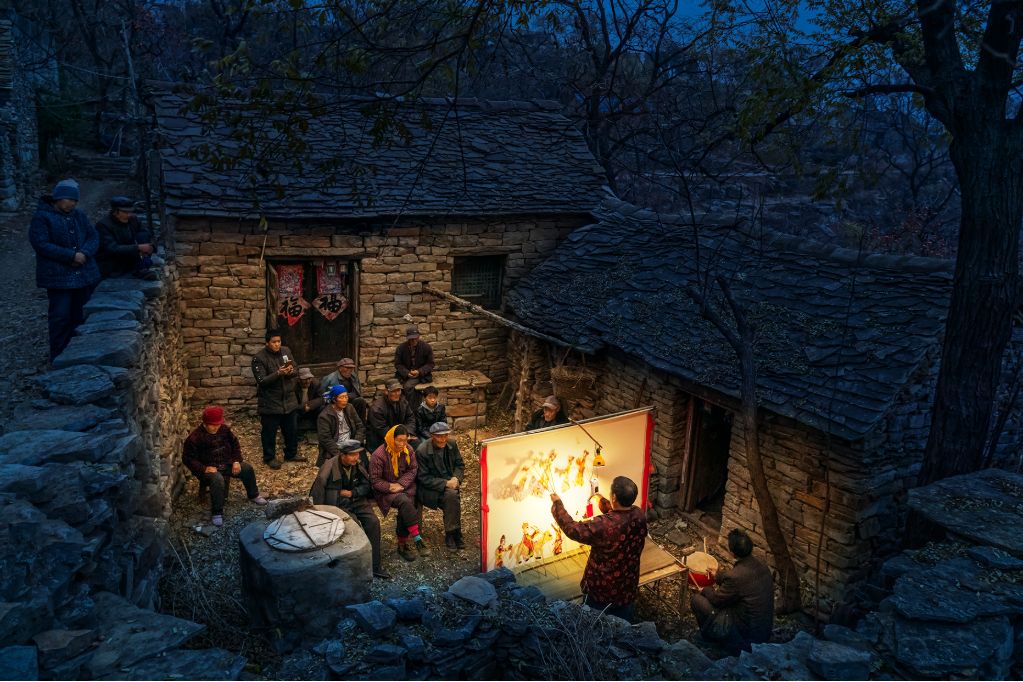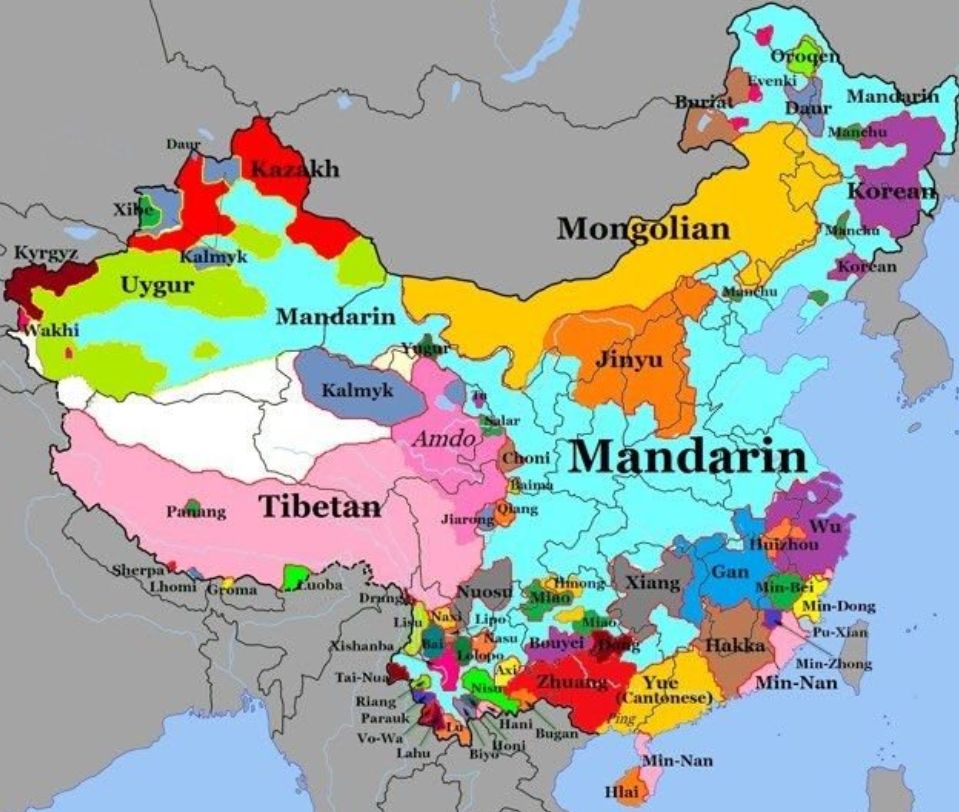Eric Vandenbroeck
30 Jan. 2020
First of all, from
what we know today it is likely that the virus will indeed become a pandemic whereby
public health services can help determine how severe it will turn out to be.
Our evaluation of any
infectious disease is based on two factors: How fast and easily it transmits,
and how serious it is. At the moment the 2019-nCoV coronavirus outbreak so far
is not as lethal as either SARS or the currently simmering Middle East
Respiratory Syndrome (MERS) on the Arabian Peninsula. Yet this variant is
packing a vicious punch and unlike SARS or MERS, is spreading far and wide,
acting like an influenza virus in terms of transmission between people, quickly
and efficiently traveling through the air. Viruses don’t change when crossing
political borders, so we can expect this one to continue behaving as they did
in China. Nothing any government can do will effectively stop its spread.
World Health
Organization officials said Thursday (30 Jan.) morning in China that the coronavirus
death toll has climbed to 170, and more than 7,700 cases have been reported
worldwide.

And whilst as
mentioned above early indications so far show it is not as deadly as SARS, the
coronavirus that emerged in China in 2002, it’s
spread has certainly matched the growth of the SARS outbreak.
The reason why the
new infectious disease is so alarming is as tens of cases become hundreds and
hundreds become thousands, the mathematics run away with you, conjuring
speculation about a health-care collapse, social and economic upheaval, and a
deadly pandemic. The other is profound uncertainty. Sparse data and conflicting
reports mean that scientists cannot rule out the worst case, and that lets
wrong information thrive.
So far, we know the
disease has taken hold in China and there is a high risk that it spreads around
the world; it may even become a recurrent seasonal infection. It may turn out
to be no more lethal than seasonal influenza, but that would still count as
dangerous in the short term that would hit the world economy and, depending on
how the outbreak is handled, it could, as we will see underneath, also have
political effects in china.
The most significant
uncertainty is how many cases have gone unrecorded. Modeling by academics in Hong Kong suggests
that tens of thousands of people have already been infected and that
the epidemic will peak in a few months’ time. if so, the virus is more
widespread than thought, and hence will be harder to contain, but it will also
prove less lethal, because the number of deaths should be measured against a
much broader base of infections. As with the flu, a lot of people could die
nonetheless.
Scientists have
started work on vaccines and on treatments to make infections less severe,
but these are six to 12 months away, so the world must fall back on
public-health measures. in china that has led to the
biggest quarantine in history, as Wuhan and the rest of Hubei province have
been sealed off. the impact of such draconian measures has rippled throughout china. the spring holiday has been extended, keeping
schools and businesses closed. the economy is running on the home-delivery of
food and goods.

Many experts praise china’s efforts. Certainly, its scientists have coped
better with the Wuhan virus than they did with Sar's in 2003, rapidly detecting
it, sequencing its genome, licensing diagnostic kits, and informing
international bodies. China’s politicians come off less well. They left alone
the crowded markets filled with wild animals that spawned Sar's. With the new
virus, local officials in Wuhan first played down the science and then, when
the disease had taken hold, enacted the draconian quarantine fully eight hours
after announcing it, allowing perhaps 1m potentially infectious people to leave
the city first.
That may have
undermined a measure which is taking a substantial toll. China’s growth in the
first quarter could fall to as little as 2%, from 6% before the outbreak. As
China accounts for almost a fifth of world output, there will probably be a
noticeable dent on global growth. Though the economy will bounce back when the
virus fades, the reputation of the communist party and even of Xi Jinping may
be more lastingly affected. The party claims that armed with science, it is
more efficient at governing than democracies. The heavy-handed failure to
contain the virus suggests otherwise.
The “people’s leader”
If censors in
communist-led regimes are good for anything, it is spurring creativity. With a
new coronavirus stalking china, netizens have been
heaping praise on “Chernobyl”, an American-made television drama about the
soviet union’s worst nuclear disaster. Their aim is to sneak discussion of the
outbreak onto china’s tightly policed internet. In
less hectic times, censors would swiftly stamp out such impertinence. For the
parallels with the reactor explosion in 1986, and the official cover-up that
followed, are painful for china’s communist party
bosses, whose system of government was cribbed from soviet designs. But pointed
comparisons keep popping up on china’s social media.
One urges Chinese viewers to learn from “Chernobyl” that a free flow of
information offers more security than aircraft-carriers, moon landings, and
other signs of superpower might. Another contrasts a soothing interview granted
to state television by the governor of Hubei, the province where the epidemic
began, with a speech by the hero of “Chernobyl”, a soviet scientist, about the
costs of official lies.
Parallels are likely
to continue in the real world. Back in the 1980s, kremlin leaders scapegoated
local officials and engineers, coolly blaming them for the disaster and denying
a more extensive cover-up. In recent days, Chinese state media have dropped
heavy hints that the mayor of Wuhan, the industrial city where the virus was first
detected, will lose his job. When Li Keqiang, china’s
prime minister, was appointed to oversee virus-control work, cynics suggested
that his role was to take the fall should the outbreak spark a pandemic, in
effect, to protect the president xi Jinping.
As it happens,
censors should be relieved that Chinese netizens are focusing on the ills of
soviet collective leadership. it would be more dangerous if online critics were
to start exploring a historical parallel closer to home, namely the way that in
Chinese history natural disasters undermined an emperor’s claim to rule. More
than one dynasty fell after catastrophes signaled that heaven had withdrawn its
favor. It was not only seen as ineptitude when a ruler was unable to protect
his people from floods or famine, or, as in the second century during the Han
dynasty, from repeated outbreaks of disease (probably smallpox and measles)
that killed perhaps a third of the population. Such bungling showed that the
emperor lacked virtue and deserved to be overthrown, people said.
Modern-day Chinese
may not believe that a rampaging coronavirus signals divine anger with Xi.
still, the party chief has a great deal at stake in this crisis, precisely
because broad claims are made about his wisdom, which is now taught in schools
and studied by party members as xi Jinping thought. Every day, state media
credit Xi with personally guiding china to
ever-greater prosperity, modernity, and global clout. No leader has amassed
such individual power since Mao Zedong or been so lavishly praised. Chinese
intellectuals accuse Xi of claiming the mantle of an emperor. They point to
xi’s speeches praising traditional Asian culture and lauding codes of morality
and deference to imperial authority, as handed down by Confucius and other sages.
The result is an
awkward hybrid. On the one hand, officials make claims about the efficiency of
collective party leadership that would be familiar to any soviet apparatchik.
To them, populist insurgencies sweeping the west are proof that multiparty
elections, a free press, and other forms of democratic accountability are
sources of chaos and dysfunction. As they describe it, china’s
system is a meritocracy that selects highly competent experts to run the
country, with a track record of correcting their own mistakes. Yet at the same
time, the party’s propagandists lay claim to a very different form of
legitimacy, involving the people’s love for and trust in one man, xi. so
sweeping is their praise of him that it leaves essentially no room for the idea
that xi could make a serious mistake.
This convoluted claim
to legitimacy can be heard in the context of the current coronavirus outbreak,
as leaders insist that their system of government is ideally suited to tackling
the disease. On 28 January Chinese
leaders hosted
the head of the world health organization (who), a un body that played an invaluable
role in demanding transparency in 2003 after china’s
initial cover-up of the extent of an outbreak of severe acute respiratory
syndrome (sars), which led to many avoidable deaths.
Wang Yi, the foreign minister, assured the who’s boss Tedros Adhanom
Ghebreyesus that china would be more resolute this
time thanks to “the
strong leadership of the party central committee with comrade xi jinping as the core and the strong advantages of the
socialist system”, as well as its experience of sars.
It is too simplistic
to assume that all bad things that happen in china
must harm xi. the virus outbreak could end swiftly, amid worldwide praise for
the bravery of china’s doctors and nurses, the
self-discipline of the public, and the resolve of Chinese leaders, albeit after
a slow start. If the crisis does not end well, scapegoats will be found, and
underlings punished. That alone would not have to shake xi’s authority, which
can always be shored up with repression, still greater ideological discipline,
and nationalist propaganda. But a botched response to the virus would lay bare
tensions inherent in the party’s hybrid claims to legitimacy.
Xi’s china is two things at once. It is a secretive, techno-authoritarian
one-party state, ruled by grey men in unaccountable councils and secretive
committees. It also claims to be a nation-sized family headed by a patriarch of
unique wisdom and virtue, in a secular, 21st-century version of the mandate of heaven.
If forced to choose between those competing models, bet on cold, bureaucratic
control to win out. For Xi and his team learned their lesson from the soviet
union’s fall, five years after the Chernobyl disaster. Expressions of public
love for Xi, the “people’s leader,” are all very well. But keeping power is
what counts.
Chinese abroad unfairly countered with the
"yellow peril" narrative

In the past two days,
the hashtag #jenesuispasunvirus, "I am not a virus" in French,
trended on Twitter as thousands of ethnically Asian internet users spoke out against
the surge in discrimination.
Airlines halt flights
from China. Schools in Europe uninvite exchange students. Restaurants in South
Korea turn away Chinese customers.
As a deadly virus spreads
beyond China, governments, businesses and educational institutions are
struggling to find the right response. Safeguarding public health is a
priority. How to do that without stigmatizing the entire population of the
country where the outbreak began, and where nearly a fifth of all humans
reside, is a challenge. French regional newspaper Courrier
Picard sparked outrage with its headline "Yellow Alert" on a
front-page story about the coronavirus. The paper apologized to readers who
took to Twitter to condemn the allusion to "Yellow Peril," a
xenophobic term referring to the peoples of East Asia that dates to the 19th
century. In Denmark, the Chinese Embassy called on the country's
Jyllands-Posten newspaper to apologize for an editorial cartoon that depicts
China's flag with virus symbols instead of stars on a red background.
Disinformation spread
When reports of a new
coronavirus emerged within a week or so a theory would be circulating that
coronavirus was a new kind of “snake
flu”– mostly because it’s unlikely the virus originated in snakes, and it’s
not flu.
So where did the
snakes come from? The culprit was a widely shared
scientific paper, which speculated that the new virus had genetic
characteristics and implicated snakes as the source. Leading geneticists were
quick to point out that the results weren’t convincing, and that bats were
still the likely suspects. However, that didn’t stop snake flu from going
viral. Other misinformation about coronavirus has rippled across the internet
in recent weeks. From claims the virus is part-HIV
to conspiracy
theories about bioweapons and reports suggesting the virus was linked to
people eating bat
soup, stories sparking fear seem to have overtaken the outbreak in real
life.
To fully explain how
viral content – and viruses – spread, we need to move away from the idea that
outbreaks involve simple clockwork infections, passing along a chain from
person to person to person until large numbers have been exposed. During the
2015 outbreak of the Mers coronavirus in South Korea, 82 out of 186
infections came from a single “superspreading event” in a hospital where an
infected person was being treated. It’s not yet clear how common such
superspreading is in the current outbreak, but we do know that these kinds of
events are how information goes viral online; most outbreaks on Twitter are
dominated by a handful of individuals or media outlets, which are responsible
for a large proportion of transmission. If you heard about snake flu, you might
have told a couple of friends; meanwhile, newspaper headlines were telling
millions.
Ensuring the public
has the best possible health information is crucial during an outbreak. At
best, misinformation can distract from important messages. At worst, it can
lead to behaviour that amplifies disease
transmission. The novelty of coronavirus makes the challenge even greater,
because viral speculation can easily overwhelm the limited information we do
have.
Not to mention that
while it might soon reach the capital cities of all 'regions' there are many
'places' in China's rural areas where the coronavirus will not reach...

Linguistic diversity in the various
regions of China:

For updates click homepage here